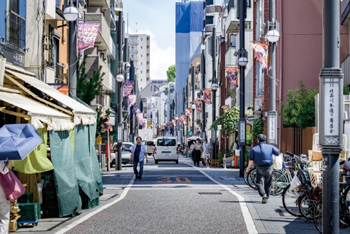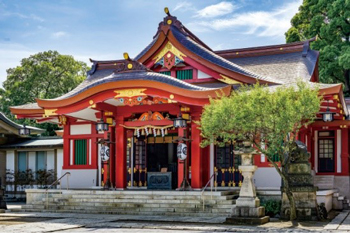
Please enable JavaScript to use the website of the Tokyo Metropolitan Government.
Main content starts here.
| Depending on the COVID-19 situation, information contained in this article may be subject to change. Please check the website(s) below for the latest information. Before going out, please check for the latest information on the COVID-19 situation. Thank you for taking measures to prevent the spread of COVID-19. ※The September edition was produced on the basis of information accurate as of August 17. |
A Perfect Day in Tokyo 9/2022
Sense the past in a former post town of the Edo period
Kyu-Tokaido Shinagawa-shuku(Shinagawa-ku)

The four-century-old Tokaido Road is still here
today as a shopping district
Shinagawa-shuku, the first “post town” on the Tokaido Road (a route linking Edo and Kyoto) during the Edo period (1603-1867), stretched between today’s Kitashinagawa Station and Aomono-yokocho Station on the Keikyu Main Line. Let’s walk around this two-kilometer neighborhood and discover traces of the Tokaido Road from the days of Edo.
Yatsuyama Bridge at the north side of the Keikyu Railway’s Kitashinagawa Station, where the JR Line, Keikyu Main Line, and National Route 15 intersect, marks the entrance to Shinagawa-shuku. Arriving at Kyu-tokaido Street, the former Tokaido Road, you will spot guide panels providing information that will make your stroll around the area even more enjoyable. These include a panel indicating the location of the former site of Dozo Sagami, a high-class brothel where insurgents in the last days of the Tokugawa Shogunate secretly held meetings.
If you walk down a side street toward the sea, you will find rows of boats moored in the waters of Shinagawaura. The sight of fishing boats and yakatabune (traditional pleasure boats) docked there is just like a scene from Utagawa Hiroshige’s “The Fifty-three Stations of the Tokaido Road”. The Shinagawaura shallows also appear in a rakugo story (Japanese comic storytelling) titled Shinagawa Shinju as a place where a suicide drowning failed because the waters were too shallow.
Continue south on the Kyu-tokaido Street flanked with shops ranging from restaurants and grocery stores to clothing and shoe stores. Old wooden stores that give off a sense of history, signboards of stores that are more than a hundred years old, copper-clad shop buildings, and more exude an ambience of continuity from the Edo period.
The avenue intersects with the approach to Shinagawa-jinja Shrine. Make a turn to the west here to get to this venerable shrine, which has special connections to the Tokugawa Family and Minamoto no Yoritomo (1147-1199), the first shogun of the Kamakura Shogunate. Ascend a flight of 53 stone steps and be awed by the colorful shrine that appears before you. Midway up to the shrine, there is a steep trail leading to fujizuka, a miniature replica of Mount Fuji built in the Edo period for worship of the sacred mountain. From atop the mound, sightseers can revel in a view of Shinagawa-shuku.
Along the avenue, you will find plenty of resting spots such as Shinagawa-shuku Koryukan (Community Lounge) and outdoor benches, from which you can feel the local people’s consideration for travelers. When you cross the Meguro River, a famous cherry blossom viewing spot, you are halfway through the stroll around Shinagawa-shuku. This is the perfect place for walking, taking respite under the trees, and imagining the past by checking out various signage.

Shinagawa-jinja Shrine founded in 1187
Download this photo as wallpaper from here.
A one-minute walk from Kitashinagawa Station on the Keikyu Main Line
<Inquiries about sightseeing in Shinagawa-ku>
[Shinagawa Tourism Association]
Phone 03-5743-7642.
Open daily from 9:30 a.m. to 5:00 p.m. (except on Sundays, public holidays, and the year-end and New Year period).
Website (external link)
*This article is also available in other languages. (日本語/中文/한국어)